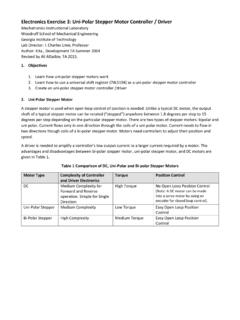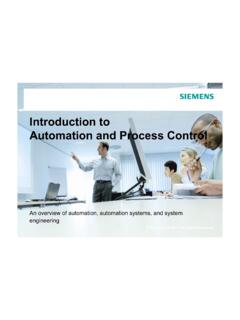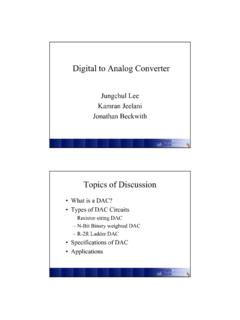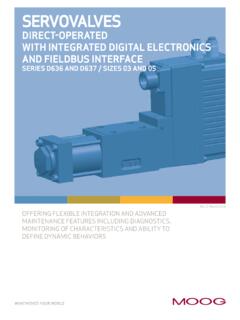Transcription of Electro-Hydraulic Servo Valve Construction, Models and Use
1 Electro-Hydraulic Servo Valve Construction, Models and Use From Merritt, H. E., Hydraulic Control Systems, J. Wiley, 1967. The input to an Electro-Hydraulic (EH) servovalve is typically a current or a differential current that powers an electromagnetic torque motor. The differential current i is typically supplied by an amplifier to avoid excess loading of the interface to the computer or controller. In the simplest (but not typical) form, the torque motor moves a spool Valve as shown below. The spool Valve allows the hydraulic fluid to pass from the supply to the return across two variable metering orifices with a controlled flow rate QL. If the spool is shifted in the other direction the direction of flow will reverse.
2 Since the clearances between the spool and the Valve body is small, the forces required to move a large spool are large. Hence the single stage or direct acting EH Valve is limited to low rates of flow (small valves ). Figure 7-11 from Merritt shows the pictorial representation of the motion system in this case. In order to achieve higher flow rates, a two or three stage servovalve may be necessary. In this case the torque motor controls the first stage Valve that actuates the spool on the second stage. The first stage Valve is typically not a spool Valve but either a flapper-nozzle Valve or a jet pipe Valve . The flapper-nozzle is more common. For these valves flow passes from the nozzle through a cylindrical area between the nozzle and the flat flapper that is near to it.
3 As shown in Fig 7-14 and 7-17 from Merritt, the EH Valve uses one flapper between two nozzles to produce a differential pressure that is applied to each side of the spool. The displacement of the flapper from a neutral position is powered by the torque motor and resisted by a torsional spring. The fixed upstream orifice in both types of Valve is important to allow the pressure on either end of the spool to be below the supply pressure. A small flapper motion creates an imbalanced pressure in one direction or the other on the ends of the spool of the second stage. Obviously the spool will tend to move in response to this imbalance and allow flow QL to the actuator. Since continued imbalance in pressure would quickly move the spool to its limits of travel, a form of feedback connects the motion of the spool to the effective displacement of the flapper.
4 A very small spool displacement will result in a large flow at high pressures typically used. Two common forms of feedback are illustrated in the figures from Merritt. Direct position feedback moves the nozzle with the spool as shown in Fig 7-14. Thus the equilibrium position of the spool is 1:1 with the position of the flapper. Fig 1-17 shows the force feedback arrangement in which a feedback leaf spring applies a force to the flapper to restore equilibrium. The ratio between the spring constant of this spring and the torsional spring on the torque motor determine the ratio between motion of the flapper and the spool. Valve Models Mathematical Models of the EH Valve can be constructed at various levels of detail depending on the purpose of the model.
5 The Models may represent the nonlinear square root relation between pressure and flow, or may be linearized about an operating position. When designing the Valve itself, a more detailed model is typically required than when modeling the system controlled by a well designed Valve . The model of the dynamics of the electromagnetic behavior is typically ignored or aggregated into the overall Valve behavior, for example. Block diagram 7-18 shows a very detailed model of the force feedback Valve that is simplified in the block diagram of Fig 8-5 constructed for analysis of the Valve in a position control system. The transfer function of Equation (8-17) excerpted from Merritt is further simplified.
6 This is the form you should hope to apply to a system design. Some of the parameters of this model are readily calculated, provided by the manufacturer or obtained from manufacturer s specifications. Other terms in (8-17) are better identified from aggregate measurements of the system s overall behavior. Even in this case it is generally desirable to compare the identified parameters to estimates based on first principles. The effective bulk modulus e is an example. It depends not only on the compressibility of the pure fluid, but the effect of entrained air and vapor and the expansion of the walls containing a fluid. These effects are very hard to compute directly but they result in an increased compressibility (decrease bulk modulus), so the limiting case can be estimated from knowledge of the ideal properties.
7 The most common model of the load used for system design assumes the load is essentially an inertia and that ++ + =1241222sssnTsKVDKxDKhhnLceetmcevmqm where the variables are given below, along with the units in the metric system: 1/sec variable,Laplace essdimensionl ), labeled (sometimes system hydraulic of ratio damping rad/sec system, hydaulic offrequency natural essdimensionl rotation, ontrolledrotation/cmotor ratio,gear m)-(N torqueload applied externally N/m modulus,bulk effective system m Valve ,exiting fluidby compressed volume)/sec)/(N/m(m t,coefficien leakage mm nt,displaceme spool valveliters/rad nt,displacememotor liters/mm gain, flow valverad rotation,motor 2323============snTVKxDKhhLetcevmqm Possible simplifications, refinements and extensions of this model are numerous: o The simplest Valve model would give the steady state flow for a given electrical input.
8 As one can see from the final value theorem and the blocks representing the Valve in Merritt s Figure 8-5, for a step input ( sse/1)(= ) to the error signal, amplitude)(input x gain)constant (a 1)(lim)(lim0= == sdevstvKKKtxsxs Thus if the Valve dynamics are fast compared to those of the load, one can essentially ignore the dynamics of the electrical drive and the electromagnetics of the Valve , leaving the effect of the Valve as a constant. o A more accurate model of the Servo Valve spool motion is given by a first or second order transfer function. The Merritt model shows a fourth order model for the electrical drive and spool dynamics but today s electrical drives are so fast that their dynamics may be ignored.
9 See the moog Company s venerable publication, transfer Function for moog servovalves by Thayer for example Models and parameters for a high performance Servo Valve . o For an example extension, consider TL which is shown in the block diagram as an external input, when it is likely to be dependent on the flow through the Valve . This would be represented with a feedback loop representing the effects of inertia, compliance, damping, etc. of the load. o There are other connections that are of interest. The pressure in the actuator will reduce the pressure drop across the Valve orifice. This effect is not explicit in the block diagram and would require further considerations of the back pressure if it is a substantial fraction of the supply pressure.
10 Identification of Hydraulic System Parameters The model requires coefficients to be known within reasonable accuracy to be of any value. Some of the values can be measured directly, such as lengths and volumes. Other parameters may be determined in groups by certain experiments. This is particularly true of the Valve model. To identify the parameters of any dynamic experiments, a number of experiments can be performed. They include steady state measurements, time-domain measurements such as step responses, and frequency response measurements either from sinusoidal or other inputs. Often these experiments identify a coefficient of the transfer function that is a grouping of physical constants.




